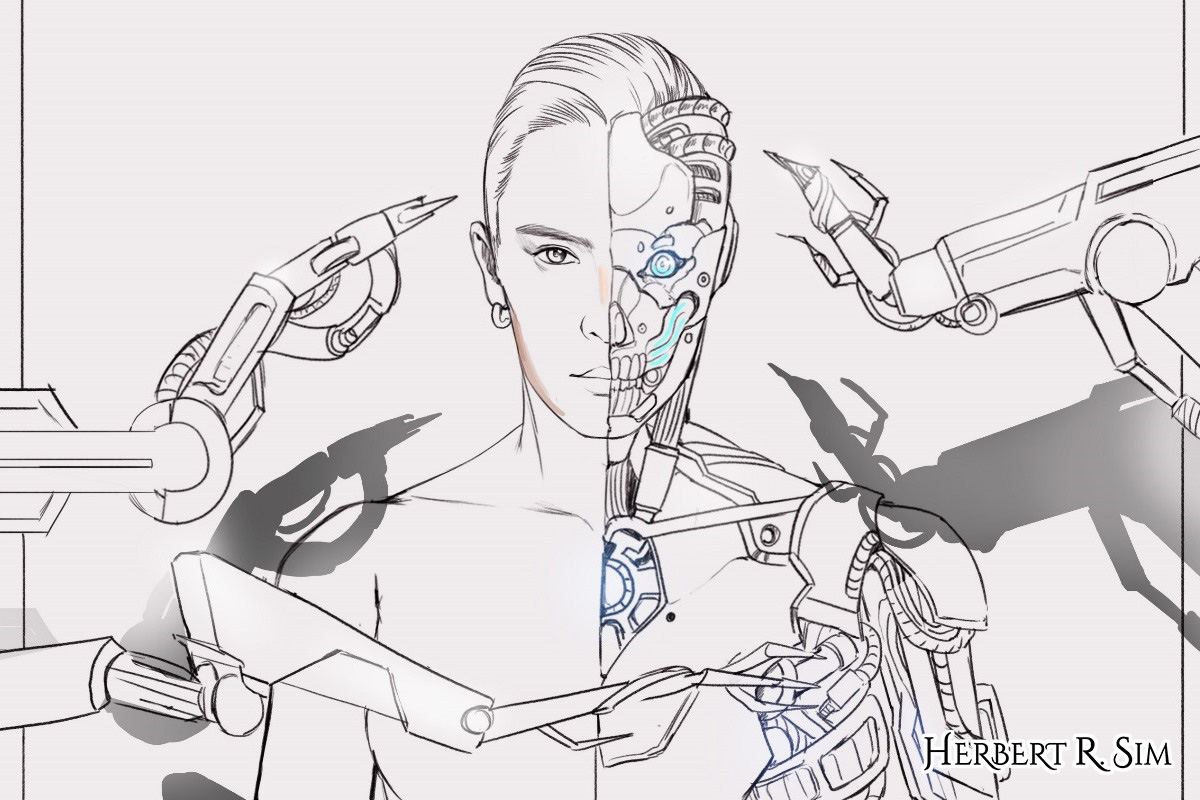
It’s tough to illustrate shape-shifting, what came to mind is the shapeshifting Terminator android T-1000 of Terminator 2. I decided to sketch a bionic woman cyborg, that has the robotics element, similar to T-800, character played by Arnold Schwarzenegger.
———————————————————
When it comes to the idea of shape-shifting, the concept is somewhat bounded by what we’ve seen, for example, on the big screen: The elusive yet charming Mystique in the highly successful Marvel series and DC’s Beast Boy – with his immaculate shape-shifting skills. It is hard to fathom how such an ability, or even the science behind it, can be mimicked and replicated by researchers in the real world, let alone achieve any feasible form of tangible success. That is, until today.
Researchers from Sun Yat-sen University, Zhejiang University, and Carnegie Mellon University have made a significant breakthrough in robotic technology, developing a deformable, magnetically controlled liquid metal for manufacturing robots. As can be seen in the demonstration video that was released, a humanoid robot made of liquid metal managed to escape a cage by simply melting inside the “jail cell”, exit, and then restoring its figure.
The shape-shifting sea cucumber
Unbeknownst to many, the impressive shape-shifting feat was inspired by an unassuming, humble source – the sea cucumber. An echinoderm often found on the ocean floor, the sea cucumber can reversibly alter the stiffness of its tissue to improve its load capacity. By replicating this unique ability in robots, researchers have taken a step closer to bringing the shapeshifting android Terminator assassin, the T-1000 is the main antagonist of Terminator 2: Judgment Day, to life, as well as offer promising applications in various fields such as biomedical technology and even space exploration.
To enable this shape-shifting ability, researchers embedded a magnetoactive phase transitional matter in liquid metal, allowing it to switch between solid and liquid states through heating with an alternating magnetic field and ambient cooling. This breakthrough concept, described in the journal Matter, yields a robot with high mechanical strength, load capacity, and rapid locomotion speed in its solid phase, as well as excellent shape adaptability in its liquid phase – including elongation, splitting, and merging.
Combining strength and flexibility
Traditional robots have limitations in manoeuvrability and flexibility due to their stiff and hard-bodied structures. Soft robots offer more flexibility but are weaker and harder to control. To address these shortcomings, the research team created a material that could shift between liquid and solid states. Gallium, a metal with a low melting point of about 86 degrees Fahrenheit, was used, and magnetic particles were embedded within it. Scientists can use magnets to control the robots, causing them to move, melt, or stretch.
The magnetic particles also make the robots respond to an alternating magnetic field, producing electricity inside the metal, raising its temperature. This induction heating causes the phase change, while ambient cooling solidifies the material again. The research team calls their invention a “magnetoactive solid-liquid phase transitional machine.”
In a series of tests, the new robot could jump up to 20 times its body length, climb walls, solder a circuit board, and escape from a mock prison. It could support an object about 30 times its weight in its solid state.
The robot was also used to remove a ball from a model human stomach in order to demonstrate its capability. The solid robot moved quickly to the ball, melted down, surrounded the ball, coalesced back into a solid, and travelled out of the model with the object. Gallium, as mentioned earlier, was used in this experiment, but a real human stomach has a temperature of about 100 degrees Fahrenheit, which is higher than the melting point of the metal. More metals, according to the authors, could be added to the material to raise its melting point.
———————————————————

Above is my work-in-progress, you can see the different layers of coloring and detailing, to make the human-half as human-looking as possible, and the robotics as futuristic as possible.
———————————————————
Current developments in the shape-shifting space
The development of shape-shifting robotic technology does not stop despite the breakthrough in magnetoactive solid-liquid phase transitional machines. Researchers across the globe are working on different approaches to create adaptable robots that can change shape and function in response to various challenges and environments. Some examples include:
- Origami-inspired robots
Researchers at MIT’s Computer Science and Artificial Intelligence Laboratory (CSAIL) have developed a series of robots inspired by origami, the Japanese art of paper folding. These robots can fold into various shapes and perform a variety of tasks such as gripping, lifting, and moving objects. In fact, such a technology has the potential to be used in areas such as search and rescue operations, where robots must navigate tight spaces and adapt to changing environments.
- Soft robotics and artificial muscles
Soft robotics is another approach to create shape-shifting robots. Soft robots are made of flexible materials, making them more adaptable and better suited for tasks that require delicate handling. Researchers at Harvard’s Wyss Institute for Biologically Inspired Engineering have developed soft robots that can change shape and function using artificial muscles. These robots are capable of performing tasks like gripping, lifting, and even crawling, making them suitable for applications in healthcare, agriculture, and environmental monitoring.
- Modular robots
Modular robots consist of multiple interconnected units, allowing them to reconfigure themselves into different shapes and structures to perform various tasks. Researchers at the University of Pennsylvania’s GRASP Laboratory have developed a modular robot called SMORES-EP, which can autonomously change its shape and function. This type of robot can potentially be used in construction, disaster relief, and space exploration.
Perks of shape-shifting robotic technology
Indeed, the development of shape-shifting robotic technology can offer benefits that span myriad industries and applications. By harnessing the power of adaptive materials and advanced control mechanisms, these innovative robots can adapt to different environments and tasks, while significantly enhancing their versatility. Such an approach to robotics will help redefine traditional industry boundaries, streamline processes, and improve overall efficiency, paving the way for further scientific advancements. Some of the industries and applications that stand to benefit include:
- Biomedical applications
Shape-shifting robots have the potential to revolutionise medicine by providing minimally invasive diagnostic and treatment options. A shape-shifting robot, for example, could be used to navigate the human body, delivering targeted drug therapy or removing foreign objects while causing minimal damage to surrounding tissues. Furthermore, these robots could be used to design custom-fit prosthetics and implants that adapt to the patient’s body over time, resulting in a more comfortable and effective solution.
- Search and rescue operations
In disaster situations, shape-shifting robots can navigate through tight spaces and adapt to different environments, making them valuable tools for search and rescue operations. These robots can help locate trapped individuals, deliver essential supplies, and even provide structural support to unstable buildings.
- Environmental monitoring
Shape-shifting robots can be deployed for environmental monitoring, adapting to various terrains and environments to collect data on air and water quality, temperature, and other factors. This information can be vital for understanding the impacts of climate change and implementing effective conservation measures.
- Space exploration
By adapting to the unique challenges and environments encountered in space, shape-shifting robots can play an important role in space exploration. These robots can reconfigure themselves for various tasks such as spacecraft assembly and repair, exploring the surfaces of other planets, and collecting samples from asteroids.
- Manufacturing and assembly
Shape-shifting robots can adapt to different tasks in manufacturing and assembly, increasing efficiency and reducing the need for multiple specialised machines. These robots can change shape and function to drill, cut, weld, and assemble components, making them valuable tools in industries such as automotive, aerospace, and electronics.
- Entertainment and education
Shape-shifting robots can be used to create interactive toys, animatronics, and immersive experiences in the entertainment industry. These robots can alter their appearance and behaviour, providing users with a dynamic and engaging experience. Shape-shifting robots can also be used in educational settings to teach robotics, engineering, and programming concepts, inspiring the next generation of innovators.
———————————————————

In my finale completed illustration, you can see the detailing of the mechanics of the robots, a prelude to my earlier 2015 artwork of AI robot ZOFIA.
———————————————————
What will the future hold?
Although shape-shifting robotic technology possesses considerable potential, several obstacles must be addressed before its widespread implementation. A key challenge lies in designing efficient techniques for regulating the robots’ form and locomotion. Overcoming this issue calls for progress in the domains of material science, sensing technologies, and control algorithms to guarantee accurate and agile control capabilities.
Another challenge lies in the scalability of shape-shifting robots. While the current developments showcase impressive capabilities at a small scale, scaling up these robots to perform tasks in larger, more complex environments will require further research and development.
Furthermore, ensuring the safety and reliability of shape-shifting robots is vital, especially when they are used in medical, rescue, and other critical applications. This warrants extensive testing and validation to ensure that the robots can carry out their intended functions without causing harm or failure.
Despite the perceived challenges, the future of shape-shifting robotic technology remains promising, with continuous research and development being carried out globally. As new breakthroughs emerge and existing technologies mature, shape-shifting robots will undoubtedly play a more significant role in various industries, altering the way we approach tasks and solve problems.
slot gacor
slot gacor
situs slot
rtp slot
slot gacor
situs slot
rtp slot
slot thailand
slot thailand
